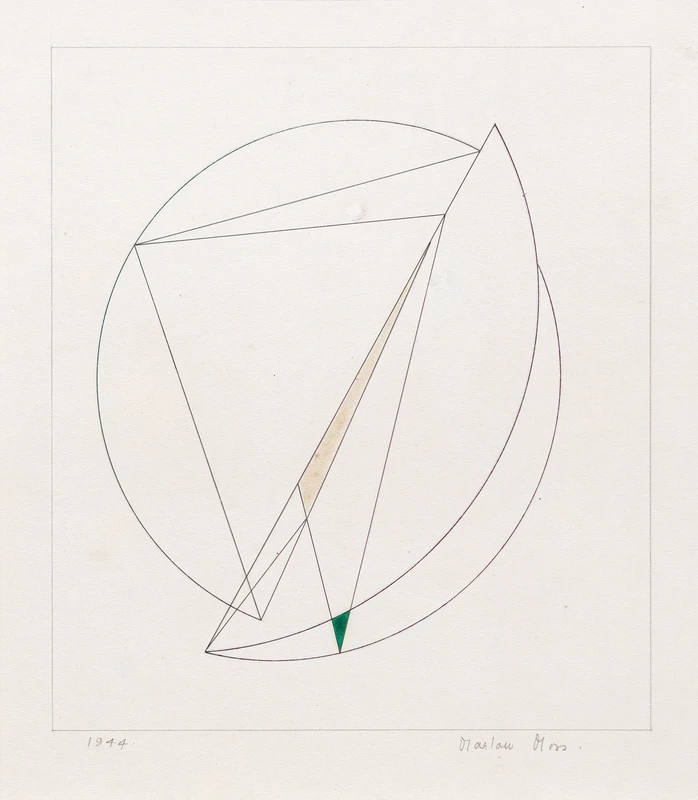Marlow Moss and Vera Molnár: New Angles
4 Sep-1 Oct 2024


The Mayor Gallery announces our forthcoming duo exhibition featuring the works of Marlow Moss (b. 1889 Richmond - 1958 Penzance, UK) and Vera Molár (b. 1924 Budapest, Hungary - d. 2023 Paris, France). Both Woman artists, pioneers in their field, Moss with her precise drawings, executed with pencil, ruler and compass, Molnar, with early computer plotter apparatus. The Mayor Gallery draws a dialogue between their respective practices that explore potency of line.
Born Marjorie Jewel Moss, Marlow Moss (b. 1889 Richmond - 1958 Penzance, UK), as she became, moved from London to Paris in 1927 enrolling at the Académie Moderne studying with Fernand Léger. Here she was part of the vibrant art scene, exhibiting regularly (Konstruktivisten, Basel 1937, and Abstracte Kunst, Amsterdam 1938) after being invited to join Abstraction-Création as a founder member along with Piet Mondrian, Georges Vantongerloo, and Jean Arp, amongst others. It was also here she met her lifelong partner, the Dutch writer Antoinette Hendrika Nijhoff-Wind.
Moss followed the concepts of De Stijl and Neoplasticism; the reduction to the essentials of form and composition through horizontal lines and primary colours, but it was Mondrian that influenced Moss the most profoundly. They became friends, exchanging Constructivist ideas and influencing each other; Mondrian and Gorin took up using her innovative ‘double line’ motif. The difference being that Mondrian constructed his compositions intuitively, while Moss constructed them using a mathematical approach.
Moss’ working drawings are precise, executed with pencil, ruler and compass. These drawings are edged with notes and calculations in pencil, often including collage before being transferred to the canvas. Tragically, much of her early art had been destroyed in the war soon after she fled France to Cornwall where she stayed for the rest of her life.
Her queer, androgynous persona, perhaps too modern for 1950s Britain, may be a factor why she wasn’t embraced by her St. Ives Group neighbours and for her later obscurity. However, her work is now being rediscovered; in 2014 Tate Britain held a solo exhibition of her work and in 2017 at the Haus Konstruktiv Zürich. Her work is in the collections of the Museum of Modern Art, New York, the Rijksmuseum and Stedelijk Museum in
Amsterdam and the Israel Museum amongst others.
Vera Molnar (b. 1924 Budapest, Hungary - d. 2023 Paris, France) studied art history and aesthetics at the Budapest College of Fine Arts before moving to Paris in 1947 meeting Constructivist artists such as Jesus Rafael Soto and Victor Vasarely who shared an interest in exploring compositions based on simple geometric shapes and themes.
A co-founder of GRAV (Groupe de Recherche d’Art Visuel), 1960, including Julio le Parc and Francois Morellet, they investigated collaborative approaches to mechanical and kinetic art. Molnar was always fixated on geometric forms and creating system-based art. ‘My life is squares, triangles, lines. I am mad about lines.’ Pre-dating the computer, she invented algorithms or “machine imaginaire” that created images by following a set of pre-ordained compositional rules creating colourful abstract geometric works. Her breakthrough came in 1968 when she gained access to a computer at a research lab after teaching herself the early programming language of Fortran and could now program endless variations of algorithms through a machine. A laborious process, Molnar, using a language of 0s and 1s, fed the commands into the computer on punched cards or paper tape which were then outputted to a plotter which conveyed the image directly to paper via a moving pen or pencil. This method allowed her to investigate endless variations in geometric shape and line.
For her computer works, Molnar participated in the now legendary exhibitions Konkrete Kunst, Zurich, 1960, mounted by Max Bill and Cybernetic Serendipity at the ICA, London, 1968. Recent exhibitions include; MOMA New York, Thinking Machines: Art and Design in the Computer Age, 1959–1989, Artistes & Robots at the Grand- Palais, Paris and Chance and Control: Art in the Age of Computers at the Victoria & Albert Museum; all in 2018.